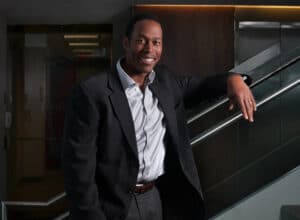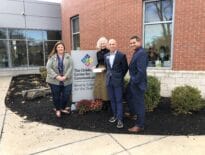Travis McCready
U.S. and Canadian Practice Leader for Life Sciences, JLL
Age: 51
Industry experience: 15 months
Travis McCready has spent much of his career focused on advancing tech-based innovation ecosystems, first as head of the Kendall Square Association and now as a top life sciences executive at commercial real estate brokerage JLL. Appointed by Gov. Charlie Baker to the new MBTA Board as the dedicated representative for “environmental justice communities” hit hardest by pollution and climate change, the Conservation Law Foundation board member will now help oversee the transit infrastructure that underpins Greater Boston’s innovation economy.
As a child of Brooklyn who started riding the New York City subway when he was seven – sometimes by himself – transit is in his bones. But today, with responsibilities across New England, his Kawasaki motorcycle is his favorite mode of transportation.
Q: The previous board was very hands-on with T leaders and very transparent with the public. Do you expect the new board to emulate both qualities?
A: This board is going through a bit of an evolution. It will not be as hands-on as the previous MBTA board, which had hour-long meetings once a week. It was very much a full-time job. It was super-transparent, and I think – for the entire ridership as well as the community at large – that phase of the board was incredibly important for raising the general knowledge base about the challenges and opportunities of public transit in Massachusetts. This new board will maintain the ethos of transparency going forward. That’s critical for any public asset. We’re also going to step away from the day-to-day, tactical, managerial oversight and dig into the strategic planning and make sure that public transit is grounded in the ways our community is growing.
Q: What transit issues are you watching most closely?
A: I think one of the biggest challenges we’ve had representing broader communities within the Greater Boston area is: How do you ensure that you can get people from point A to point B as housing patterns change, knowing that you can’t always hard-wire and build a rail line to a new community? And at the same time, how do we invest, like most major metropolitan areas have, in growing bus service in a way that’s environmentally sustainable? Looking on the horizon, that’s going to be a major cultural shift for the T. How do we invest in more bus service? The second issue that we’ve got to grapple with is these questions about affordability of public transit. Not only is public transit affordable for the individual customer and rider, but can we as a broader community afford a better public transit system? And that algorithm is going to be a challenge for us going forward.
Q: There’s a debate in some transit circles that cuts to the fundamental strategic question facing transit agencies today: Is it for suburban commuters or city-dwellers, and where should they invest most of their time and money? How do you see that?
A: My reaction is to how you framed that question is to be a little cheeky and say “yes.” One of the things the T did during the pandemic was mapping who is riding the T at what times during the day, and making sure our essential riders were able to get to their jobs, being able to social distance and making sure transit was really clean. And that’s all really important going forward. Access is a really important part of transportation. But part of it is also mode shift [from cars to transit] and I think we have to keep a parallel eye on how the Greater Boston area is growing. Choices of where people are living are going further and further from the urban core and it’s getting harder and harder to get into the city. And part of moderating climate change is making sure people can get from the suburbs into the urban core on transit. Not to be cheeky, but the answer to your question is very much both/and.
Q: You also come to the board as a leader at one of the biggest commercial real estate brokerages in the city. Does that inform how approach your role on the MBTA board?
A: I never want to be seen as anybody’s “man on the inside.” I take my responsibility of representing the community very seriously. First and foremost, I’m going to represent the community. At the same time, representing the community means that folks have the access to public transit that makes their lives viable. And in this regard, commercial real estate has a joint interest in that outcome. Landlords should worry and should be concerned about public transit policy and public transit decisions. Real estate investors should worry and should pay attention to public transit policy and decisions. Having that perspective and bringing that perspective into the conversation alongside the community focus can potentially yield a holistic viewpoint.
Q: Does the rapid growth of life sciences in Boston pose a challenge to the T’s planning efforts?
A: Life sciences don’t particularly pose a differential challenge to transit. What starts to be of concern is the rapid growth of life sciences. Where these new buildings? [Are we] thinking about the implications of those location decisions and the existing transit infrastructure? So, back to my point about rail versus bus. I think it’s fantastic and great that we extended the Green Line in Somerville to accommodate new development in Cambridge, crossing all the way out to Tufts University. On the other hand, we can’t have an expectation that the next time there’s a new life science development that’s millions of square feet [in size], we’re going to build a new rail line. These questions about transit equity mean we have to understand how we can adapt bus lines or a multimodal approach to ensure we’re not throwing a bunch of new cars on the road.
Q: What has you most excited about the T’s future?
A: We always want to do a better job ensuring transit equity in our community. To butcher a metaphor, transit equity isn’t a destination, but a journey. It’s something we must consistently work on and that’s a huge opportunity I’m excited for. The second is going multimodal. Right now, we’re very much a city that focuses on rail as a primary way of getting people from point A to B, and there is only so much we can grow as a metropolitan area focusing on that strategy. We’ve got to go multimodal and embrace bus in a different way. The third thing is how we diversify the MBTA, and I mean it in every sense of the word. Not only in terms of staff and who we employ, but also in terms of the business in Massachusetts and the minority and women-owned businesses in Massachusetts that we support. Why is that important? Transit is as much about getting people from point A to point B as it is about equity, and there’s an enormous opportunity for the MBTA to be a leader in that way, to use its purchasing power to advance the communities it serves.
McCready’s Top Five Short Runs in Greater Boston:
- Wachusett Dam Reservoir, Clinton
- Minuteman Trail, Arlington/Lexington/Bedford
- The Esplanade and Storrow Drive, Cambridge/Boston/Newton
- Prospect Hill Park, Waltham
- Mary Cummings Park, Burlington






